Dotto
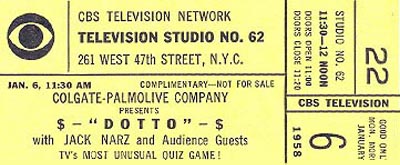
The game show Dotto aired on CBS daytime from January 6, 1958 through August 15, 1958. There was a nighttime version that ran on NBC from July 1 of that year until August 12. During the few months of its existence, it was a tremendous, highly-rated hit.
So why was it cancelled so quickly? Simple: It was rigged.
Dotto was the game show that triggered the great game show scandal. It was a simple show with two contestants competing for big prizes. On the set, each could see the same dot-to-dot puzzle. The host, Jack Narz, would ask a general knowledge question and a contestant would ring in if he or she thought they could answer it. If they were right, they banked dollars and more of the dots would be connected on the puzzle they could see. They would then have a chance to identify the image of the puzzle and if they were right, they would win the game, the money they’d banked and additional prizes. There was a little more to the game than that but not much…and it was very exciting because, in part, the producers manipulated things to make it exciting.
In May, a standby contestant named Ed Hilgemeier (nicknamed “Skinny Eddie” backstage and by the staff) watched from backstage as a woman named Marie Winn, the show’s long-running, undefeated champ, easily defeated a challenger named Yeffe Kimball Slatin. Shortly after, returning to the room where contestants were kept, Hilgemeier happened to find a notebook belonging to Winn. In it, he found the questions and answers that had just been asked on the show. Hilgemeier showed it to Slatin and together, they approached the show’s producers and threatened to go public with this evidence of rigging. The producers agreed to pay them to keep quiet.
Soon after though, “Skinny Eddie” took the matter to the Manhattan district attorney. Some reports say he was angry because the producers had declined to pay additional money he demanded. Others say he got scared that the truth would leak and he’d find himself implicated in a scandal. Either way, he blew the lid off the cover-up and it got into the press. CBS and the show’s sponsor, Colgate, looked into the matter and Dotto quickly disappeared. There was no evidence that Jack Narz was involved in the deception and his career continued, unharmed. He went on to host many other game shows, including Video Village. Not long after, it came out that some other game shows were not on the up-and-up…but Dotto was the first to fall.
Barney Miller
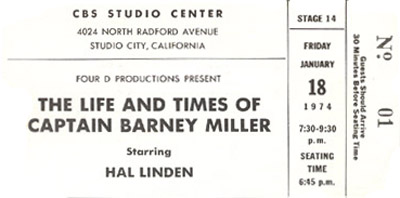

Barney Miller was a popular situation comedy which ran on ABC from January 23, 1975 to May 20, 1982. It starred Hal Linden as the Captain of the 12 precinct of the New York Police Department. Also in the cast were Max Gail, Ron Carey, Abe Vigoda, Ron Glass, Steve Landesberg, Jack Soo, James Gregory and Gregory Sierra. Some of those actors came and went (Vigoda left to star in a spin-off, Fish) and one died (Soo, during Season 5).
Abby Dalton played Miller’s wife in the pilot — taped at CBS and called The Life and Times of Captain Barney Miller — which also included Linden and Vigoda. ABC did not like the end product and the result was played off among other unsold pilots in the Summer of ’74. But in the meantime, creators Danny Arnold and Theodore Flicker had reconfigured the show and shot another pilot which ABC picked up for mid-season status. The second ticket above is from a taping done more than a month before the show debuted. The new version featured Barbara Barrie as Miller’s wife but the producers soon decided that the show should be about the Captain’s job, not his home life, and Barrie’s character wound up getting mentioned often but was rarely seen.
Barney Miller tapings were notorious throughout the industry for their marathon hours. It was not uncommon for the evening taping to be followed by a complete rewrite of the script. The audience would depart and the writers would go to work with producer Danny Arnold supervising or doing most of the heavy lifting. Retaping would eventually commence and could easily last until 1 or 2 AM. There were nights when it did not conclude until much later, with some tapings reportedly stretching until dawn. Needless to say, some episodes as aired contained nothing that had been taped before the live audience and were sweetened with canned laughter. But the show was successful and received multiple Emmys, Golden Globes and even a Peabody, so most involved seemed to think it was all worth it.
Joe Garagiola’s Memory Game
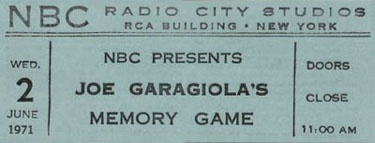
Anyone here remember Joe Garagiola’s Memory Game? That show that ran on NBC from February 15, 1971 through July 30 of the same year? The one Merv Griffin’s company created (but for some reason, didn’t put its name on) where five contestants were given all the answers to the questions in advance but only a brief time to study them, and then they had to answer as many as possible from memory? Any of this sound familiar?
Guess that explains why it didn’t last long. When it was cancelled, its host (Joe Garagiola, in case you couldn’t guess) moved over to hosting Sale of the Century and his Memory Game was quickly forgotten.
Piper’s Pets

Aaron Ruben, who was one of the main creative forces behind The Andy Griffith Show and CPO Sharkey, took a star from each and concocted Piper’s Pets — an unsold pilot. It starred Don Knotts as Dr. Donald Piper, a small town veterinarian and Peter Isacksen as his well-meaning but perpetually confused assistant, Lester. Maggie Roswell played Dr. Piper’s wife and Jacque Lynn Colton played his receptionist. NBC had it in mind as a possible mid-season replacement (which explains why it taped in September) but somehow, they felt the chemistry just wasn’t there.
Politically Incorrect with Bill Maher
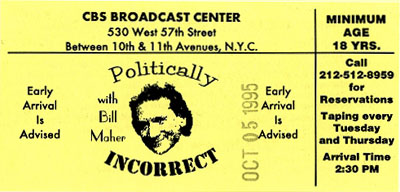
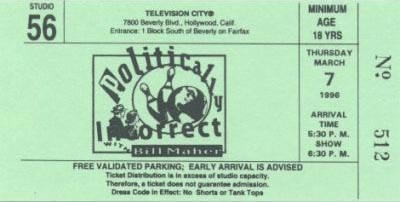
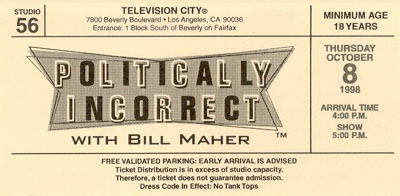
Politically Incorrect with Bill Maher debuted on Comedy Central on July 25, 1993. The format was simple: The host and four people sat around and discussed what was going on in the world. Maher opened each show with a brief monologue, then turned to his panel, which often included comedians and high-profile political figures. It was sometimes difficult to tell them apart.
The series quickly built up a following, due mainly to Maher’s skill for keeping things moving and funny. His ability to ask tough questions (and to pointedly repeat them when guests evaded) made it interesting, and even some who abhorred his Libertarian/Atheist viewpoints admired his candor and showmanship. In ’97, ABC decided the series would make a great follow-up to Nightline and the show moved over, changing only in a few cosmetic ways, continuing to offer rowdier conversation than one usually finds on a network. It went that way until shortly after the attacks of 9/11/01 when Maher made a comment that said that whatever the suicide pilots were, it was wrong to describe them as “cowards.”
In hindsight, that was a mild and inarguable statement…but at the time, it caused protests, rebukes from the White House, advertiser desertion and, ultimately, ABC dropping the show. It has been suggested that they were already uncomfy with Maher’s outspoken manner and were looking for an excuse to lop him off their schedule. Whatever the thinking, he was axed in July of 2002 but soon resurfaced with Real Time with Bill Maher on HBO.
Politically Incorrect did its early shows (usually taped, occasionally live) from CBS Broadcast Center in New York but soon relocated to CBS Television City in Hollywood, the better to secure show biz guests. No matter who was airing it, it was done there, and Real Time is also presently done from CBS Television City.
Bert Parks’ Bandstand
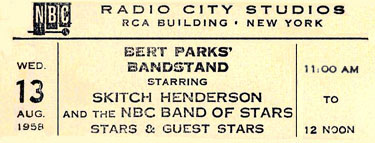
Bert Parks is probably best (only?) remembered for his years hosting the annual Miss America pageant. That’s a shame because he was a star on Broadway (among other gigs, he replaced Robert Preston in The Music Man) and he hosted dozens of game and variety shows. Bert Parks’ Bandstand was a daytime radio show based on the arguable premise that audiences didn’t want any of that new “rock-and-roll” music some kids were buying. They still wanted the Big Band sound…and that’s what Bert gave them, thanks to a fine big band under the baton of Skitch Henderson. Radio audiences kept it on for years but a TV version called NBC Bandstand didn’t do as well. The show debuted July 30, 1956 and had its last broadcast on November 23 of that year. It was replaced by a new show called The Price is Right.
That’s Life
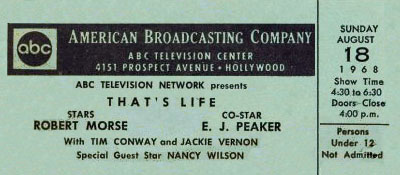
That’s Life was an extremely original and daring concept in TV: An hour-long ongoing sitcom and musical comedy that each week featured songs (some written for the show, some not) and dances. Robert Morse was the star and the show had something of the feel of his hit, How to Succeed in Business Without Really Trying. He played a young man named Robert Dickson while E.J. Peaker played his new wife, Gloria Quigley.
Each week, we got another chapter of their evolving life together, and there were guest stars aplenty. Among those who appeared, sometimes more than once as recurring characters, were Ethel Merman, Mel Tormé, Phil Silvers, Leslie Uggams, Paul Lynde, Vikki Carr, Mahalia Jackson, Alan King, Robert Goulet, Tony Randall and Liza Minnelli. Shelley Berman and Kay Medford turned up often as Gloria’s parents. The show also found ways to incorporate musical groups and their hits into its plot each week. On the first episode, which aired September 24, 1968, The Turtles sang “Eleanor.”
The above ticket is for August 18 and it’s for the second episode, which was telecast October 1 and told the story of how Bobby decided to ask Gloria to marry him. During the course of the hour, guest star Nancy Wilson sang “Marriage Blues,” E.J. Peaker sang, “It Must Be Him,” Morse sang, “Embarrassment of Riches,” Morse and Peaker sang “Our Love is Here to Stay” and”The Two of Us,” and Wilson and Peaker sang, “To Get a Man.” Guest stars Tim Conway and Jackie Vernon didn’t sing.
The series was a critical hit but that was about it. Audiences never discovered it…or if they did, they didn’t much like what they were watching. Twenty-six episodes were produced with the last airing April Fool’s Day of ’69. There were a few week of reruns and then the timeslot (Tuesday nights at 10) was given over to one night of a thrice-weekly Dick Cavett Show. That’s Life was never rerun again, which is a shame. It was one of those shows that deserved more of a chance.
CPO Sharkey

Johnny Carson used to joke that Don Rickles had had his finger in more pilots than an Air Force Proctologist. There was a time there when Rickles was appearing in an amazing array of unsold pilots and even a few that made it to series and didn’t last long. His longest run — it actually lasted a year and a half — was with CPO Sharkey, a sitcom that attempted to turn the insult comic into a latter-day Sgt. Bilko. In fact, the series was even created and masterminded by Aaron Ruben, who’d worked extensively on You’ll Never Get Rich (AKA The Phil Silvers Show, AKA Sgt. Bilko).
“CPO” stood for Chief Petty Officer. Sharkey presided over a mixed ethnic group of sailors, each of whom he derided in the Rickles style. Many of his insults were saved for Seaman Pruitt, a 6’7″ hick played by Peter Isacksen. Rickles was 5’6″ and so delivered a lot of acidic lines to Isacksen’s chest.
The show lasted 37 episodes and the above ticket was probably for one of the last ones taped. They were all done on Stage 3 at NBC, which is where Jay Leno now does his show. This is directly across the hall from Stage 1 where Johnny Carson did The Tonight Show for so many years. One of the few reasons CPO Sharkey is remembered is because of one night when Carson — allegedly spontaneously but probably planned in detail — took his cameras across the hall and interrupted a Rickles taping. The night before on Tonight, appearing with guest host Bob Newhart, Rickles had accidentally broken Carson’s cigarette box. So right in the middle of taping a scene, Don looks over and there’s Johnny Carson, walking in with a hand microphone and a busted cigarette box to demand an apology. It was very funny and the incident bolstered the ratings of CPO Sharkey…for a while. Like all TV shows starring Don Rickles, it didn’t last long.
Hudson Brothers Show, The

No sooner was The Sonny & Cher Comedy Hour a hit than its producers, Allan Blye and Chris Bearde, sought to replicate that success on Saturday morn with an act called The Hudson Brothers. Promoting Bill, Brett and Mark Hudson as the seventies version of Groucho, Harpo and Chico, CBS launched them as the summer replacement for Sonny and Cher, with a show that aired in primetime from 7/31/74 to 8/28/74. This segued into the half-hour Saturday AM version, which was called The Hudson Brothers Razzle Dazzle Show. That one lasted one year, commencing 8/7/74.
Both shows featured zany sketches and music (the Brothers had some modest record hits around then) and a family of regulars that included Gary Owens and Rod Hull. Rod Hull was an Australian comedian who worked with a large bird puppet called Emu. You can read all about Rod here.
Oddly enough, the primetime version — which had only been intended to launch the brothers in preparation for their Saturday morn show — probably fared better. There was talk of later bringing it or them back in some format but the act instead drifted through other venues and the Hudsons went their separate ways.
Redd Foxx Comedy Hour, The

Here’s another ticket for a show that taped at CBS but as you can see from the absence of those letters on the ticket, the show didn’t air on CBS. It also wasn’t called The Redd Foxx Show like the ticket says. There was a later program called The Redd Foxx Show and it was a situation comedy. This one was a variety show that was broadcast on ABC as The Redd Foxx Comedy Hour.
Mr. Foxx starred in Sanford and Son from 1972 to 1977. When it was finally cancelled, he signed a big contract with ABC and this series resulted. It was produced by the team of Allan Blye and Bob Einstein, and it was a very funny, innovative series that not a lot of people watched. Foxx was joined by regulars Billy Barty, Bill Saluga and Hal Smith, along with some of his old nightclub cronies like Slappy White and “Iron Jaw” Wilson. “Iron Jaw” was a performer who was often on nightclub bills with Foxx as an opening act. His performance consisted of linking about a dozen lightweight wooden chairs into a cluster and lifting that assemblage up in his teeth. That was about all he did but Foxx kept him working. Andy Kaufman also appeared once or twice.
When Redd left NBC, there were press reports that the main point of contention had been that the network wouldn’t give him a dressing room with a window in it. The actual reason was that, given the success of Sanford and Son, he felt he deserved a lot more money than NBC was offering and also that he had more to offer than just playing Fred Sanford. He wanted, for example, to host variety specials and to guest host The Tonight Show — the latter, a demand that was vetoed by Johnny Carson. ABC offered a lot more…so off he went. The opening of his first telecast showed a shot of the ABC studio and an announcer introduced him. You then heard the voice of Redd Foxx yelling, “I ain’t comin’ out ’til I get a window!”
What followed was a funny show but America wasn’t watching. A bad time slot (Thursday nights at 10) was one reason. Another may have been that people really only loved him as Sanford. The only attention the series got was when they did a sketch spoofing Farrah Fawcett’s then-famous hair-do, It was a visit to her home where everyone — including her parents, the maid and a parrot — wore Farrah wigs. The actress sued and ABC settled with a promise that her coiffure would not be mocked on any ABC show. For a couple years there, the main taboo on an ABC show was any joke that mentioned Farrah Fawcett. Other networks could and did make fun of her but it was verboten on ABC.
Records show that The Redd Foxx Comedy Hour debuted on September 15, 1977 and last aired on January 26, 1978. The above ticket is for January 20, which makes one suspect the taping either didn’t occur or that it resulted in a show that never aired. By March of 1980, Redd Foxx was back on series television…playing Fred Sanford again.






